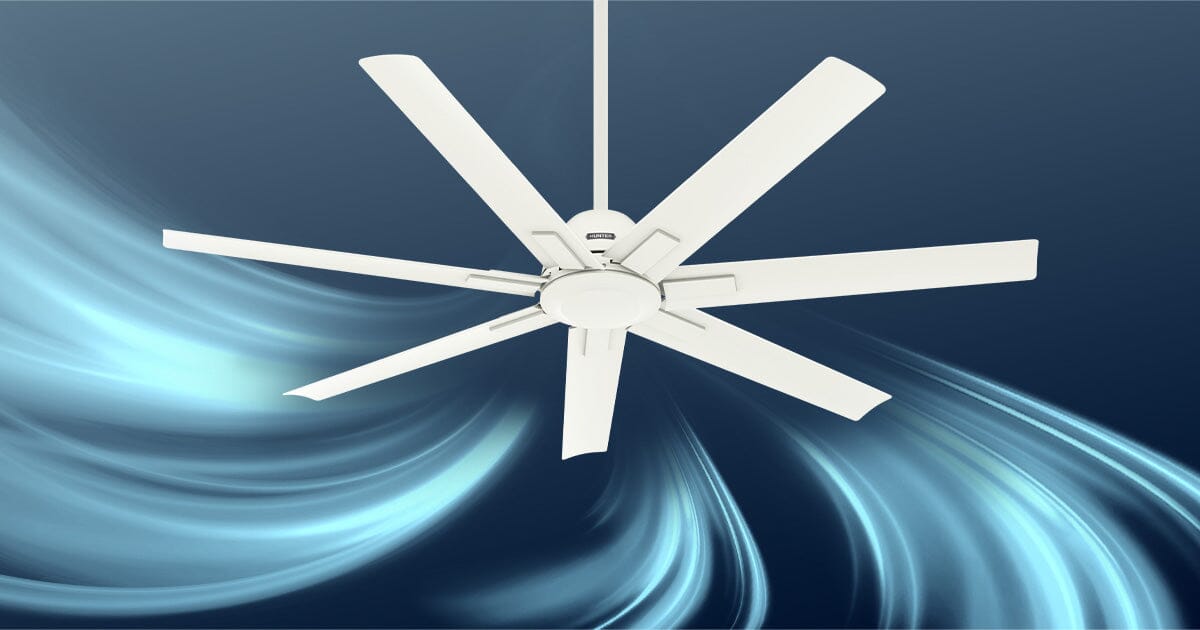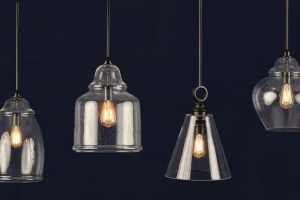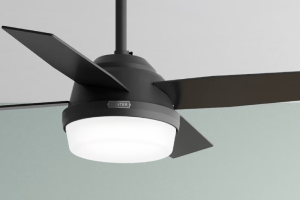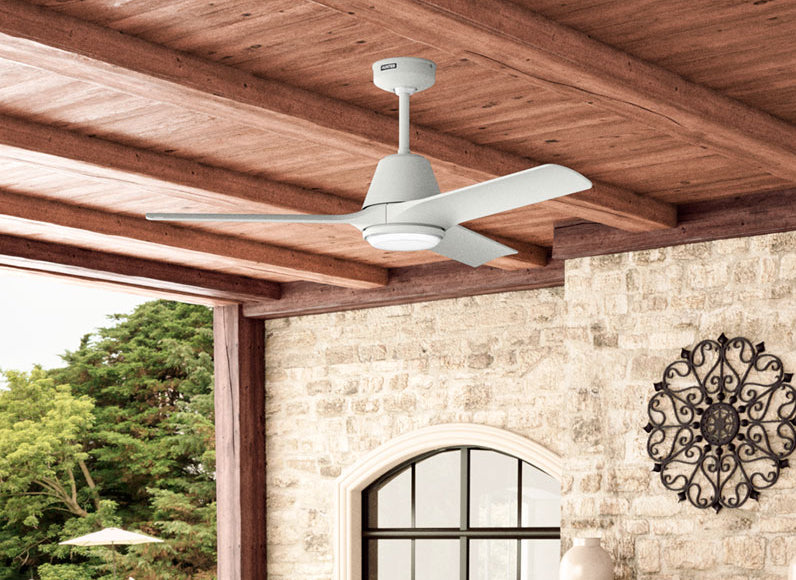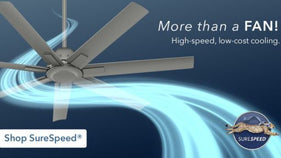There’s nothing like the feeling of a cool breeze from a fan during a summer day. To achieve it, you need a ceiling fan that moves the most air. When choosing the right fan, some look at the CFM (cubic feet per minute) number on the box or online product page. While CFM does talk about the air in relation to the fan, there are many more factors that go into a fan to produce the best airflow.
Ceiling fan CFM versus air velocity
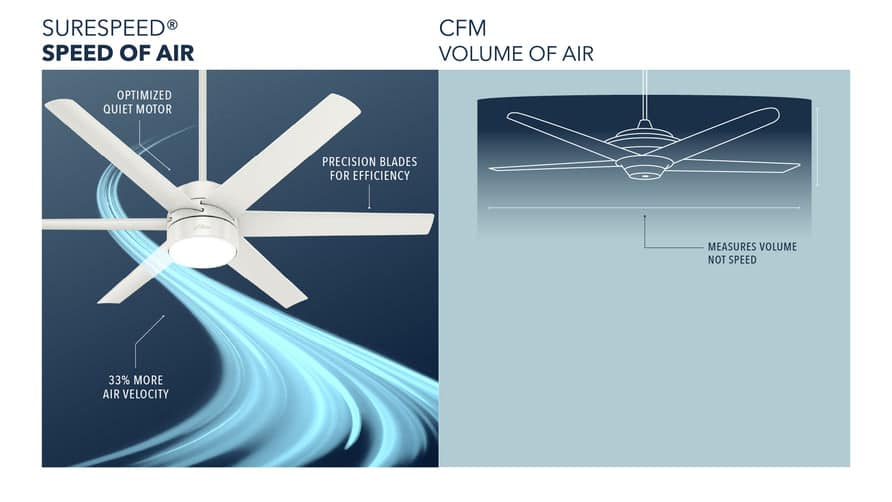
The first thing to understand when evaluating which ceiling fan moves the most air and will cool you best is the difference between CFM and velocity.
- CFM measures the volume of air a fan moves in cubic feet. The bigger the fan, the more CFM. Our lab technicians measure a fan’s CFM when it's running on high and low speed, then calculate the average. The testing measures are based on the Department of Energy’s (DOE) idea of average daily fan use.
- Airflow relates to the speed of the air movement, measured using miles per hour (mph).
Simply put: CFM measures how much air is being moved while air velocity measures how fast it moves. The bigger the fan and greater CFM, doesn’t always translate to a cooler you. Think about when you’re at a gym, Costco, or Walmart – those big fans have a higher CFM than your fan at home. Yet, the air you feel isn’t coming from that fan, it’s from a central air system. So, if they turned off the central air, you wouldn’t feel the coolness you desire.
So, if fan size and CFM doesn’t always translate to a cooler you – than what does? Let us break it down for you.
What is a good airflow for a ceiling fan?
We measured and designed our SureSpeed® ceiling fans based on airflow instead of CFM because airflow more directly translates to what you feel from a fan. Ceiling fans work by using the “wind chill effect” to cool people – and the faster the air comes from the fan, the cooler you’ll feel. It’s a lot like when you have the window open in a moving car. Hunter ceiling fans still produce high CFM ratings. We optimize our fans’ motors and blade pitch to move a lot of air while consuming less energy.
Pro Tip: To calculate airflow efficiency, divide the CFM by the energy (measured in watts) needed for operating the fan at the high-speed setting.
Factors that determine ceiling fan airflow and velocity
Fan blade shape and pitch
The number of blades on the fan isn’t necessarily an indicator of ceiling fan airflow, but the ceiling fan blade pitch (or fan blade angle) and shape can impact airflow. Our engineering team created a contoured, aerodynamic blade design for our SureSpeed ceiling fans that push air more efficiently compared to standard flat blades. Our SureSpeed precision blades produce a more uniform and smooth flow of cooling air instead of chopping or cutting through the air like the traditional flat blade.
Ceiling fan size
Size is a big factor in efficient ceiling fan airflow. Installing a fan that's too small for your space won't circulate air effectively throughout the room. Alternatively, installing a fan that's too large for the space could overpower the room, even on a lower setting. Keep in mind that larger fans will also tend to have higher CFM due to the surface area, but that doesn’t always translate to air velocity. Be sure to look for SureSpeed if you really want to feel the difference. Our ceiling fan buying guide is a great resource for learning what the right ceiling fan size is for your space to produce the best airflow.
Ceiling fan motor performance
Even if you have the proper fan size, blade shape, and blade pitch, you still need a powerful motor to generate the movement that creates airflow. We use an optimized motor with quiet operation in our SureSpeed fans so you get better airflow using less energy.
Fan distance from ceiling and floor
The distance between the fan and the ceiling and floor depends on the style of your fan, size of the room, and whether your ceiling is angled – but it also impacts airflow. Choose the right ceiling fan mount type and downrod length based on your ceiling height for safe installation and optimal airflow and performance.
Ceiling fan direction
How can I increase ceiling fan airflow? To get the most out of ceiling fan airflow, you’ll want to make sure your ceiling fan is spinning counterclockwise in the summer. This creates a downdraft, which you feel as a cool breeze when you’re sitting under the fan. Having the fan on high speed and spinning counterclockwise will give you the coolest breeze.
During the winter, you’ll want your ceiling fan to spin clockwise at the lowest speed. The updraft helps move warm air trapped at the ceiling around the room. If you have the fan spinning clockwise but on high-speed, it counteracts the warming effect.
Ongoing innovation from the Hunter engineers
As we’ve explained, factors including blade size and shape, blade pitch, and motor performance are essential for superior air movement. At Hunter Fan Company, we are constantly testing the combination of these elements to maximize the performance of our products. From the number and shape of the blades to the motor size, the slightest change can make a difference in a fan's overall functionality and ultimately create the perfect level of comfort. Our designers' mission is to create stylish, timeless ceiling fans that also provide energy-efficient airflow. They work closely with our engineering team to create designs that also produce optimized airflow, from the interior components to the blade shape.
Explore our other innovations including WeatherMax® and SIMPLEconnect® technologies for premiere ceiling fans for use outdoors and in smart homes.
